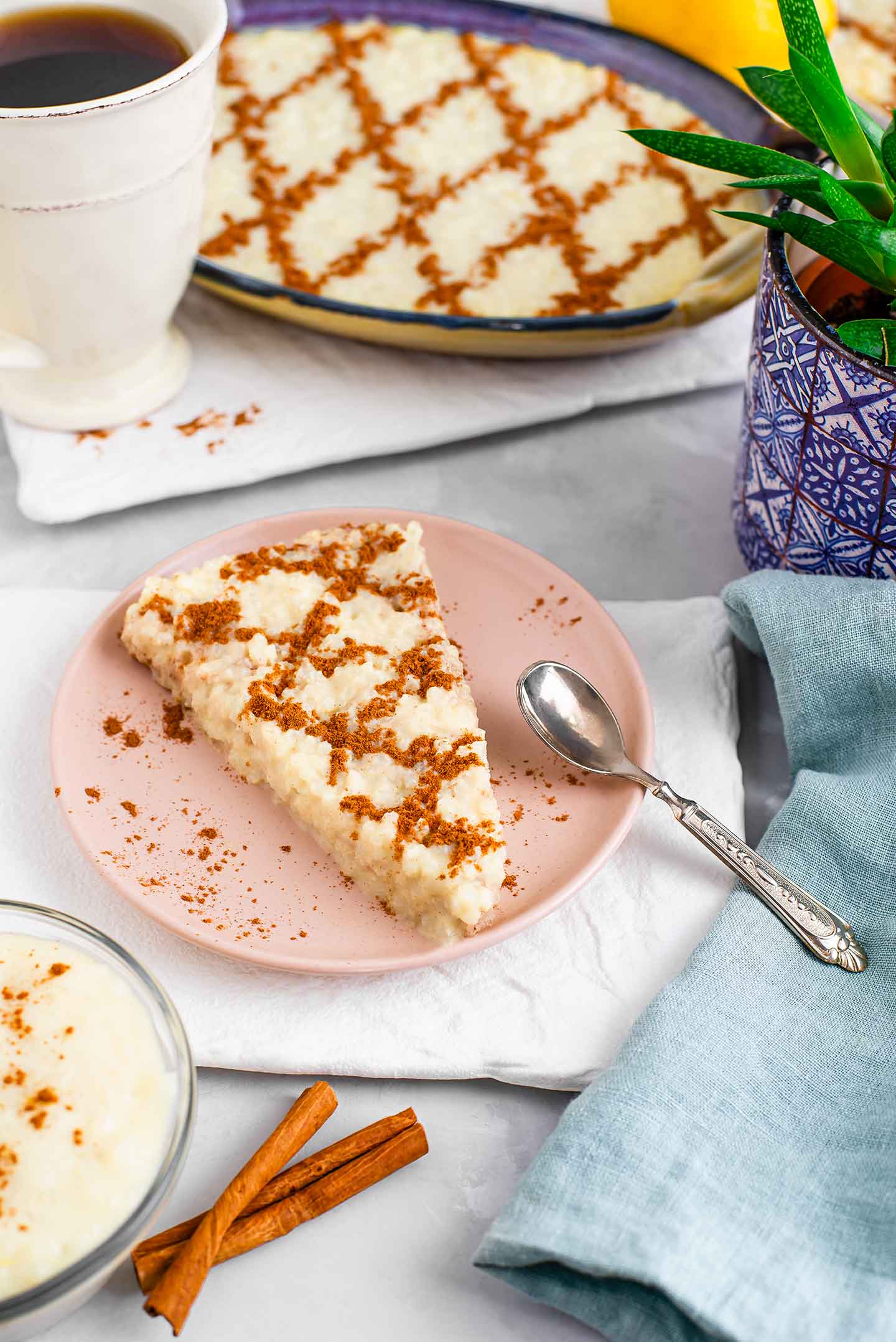
If you were to ask me for the one dessert I most often had growing up; it would be this Arroz Doce! My Portuguese grandmothers brought this Portuguese sweet rice to every family gathering. One of my favourite things to do is to try and replicate the recipes I loved in my childhood with the ingredients I always have in my pantry. So this vegan Portuguese sweet rice; inspired by the traditional version made by my avos, is dairy and egg free and just as creamy and thick!
This rice pudding is:
Less than 10 easy ingredients
Incredibly wallet friendly
A maximum of 40 minutes to make
And full of creamy, sweet, comforting flavour!
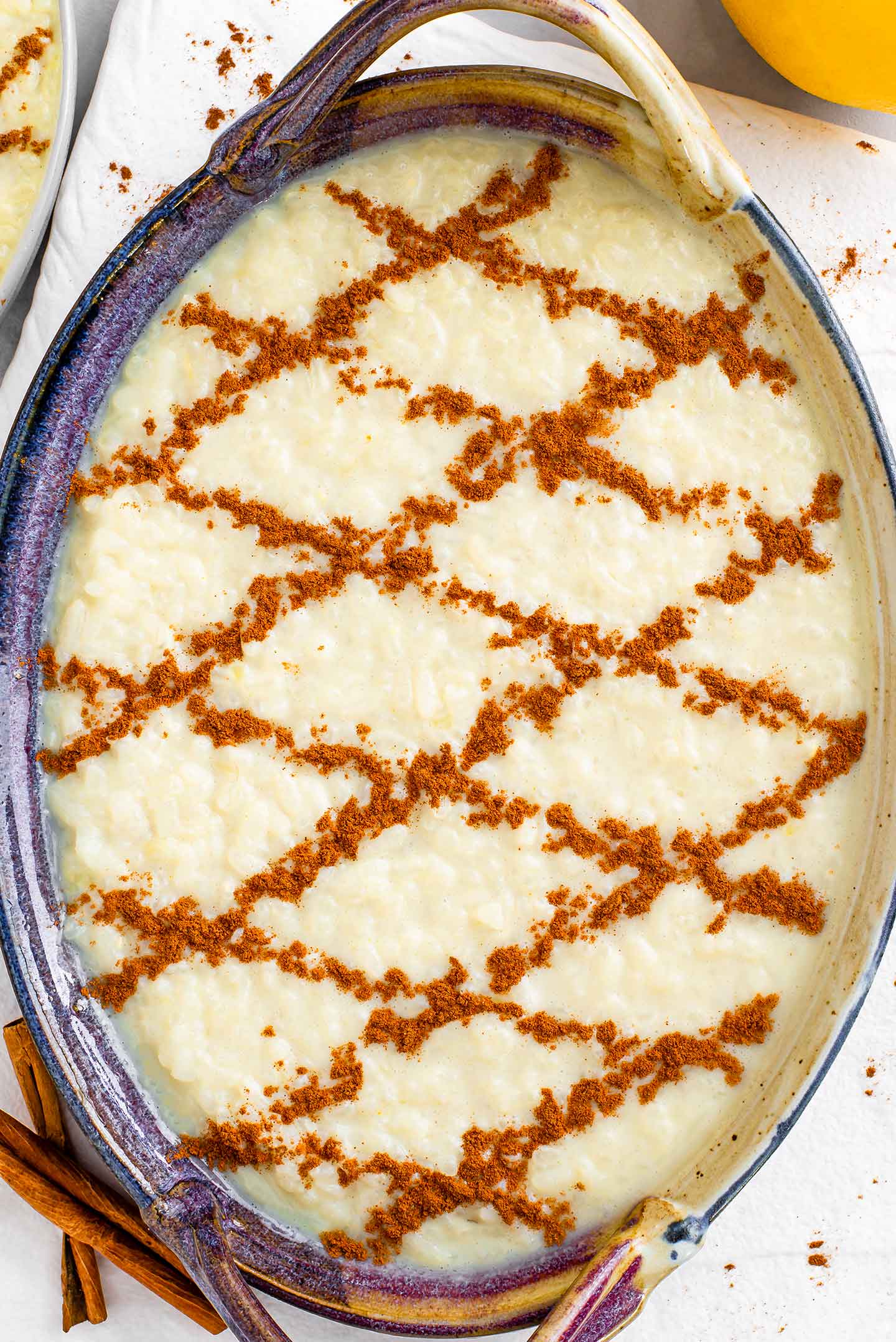
What Is Arroz Doce
Arroz doce means sweet rice in Portuguese and this rice pudding is a quick and easy popular dessert. In the traditional version; arroz doce is made with a short grain rice, lightly flavoured with lemon, sweetened, and made thick with egg yolks. For a traditional recipe take a look at Tia Maria's blog and video for arroz doce.
With a few simple swaps we are able to make our version even thriftier than the traditional!
Ingredients For Vegan Portuguese Sweet Rice
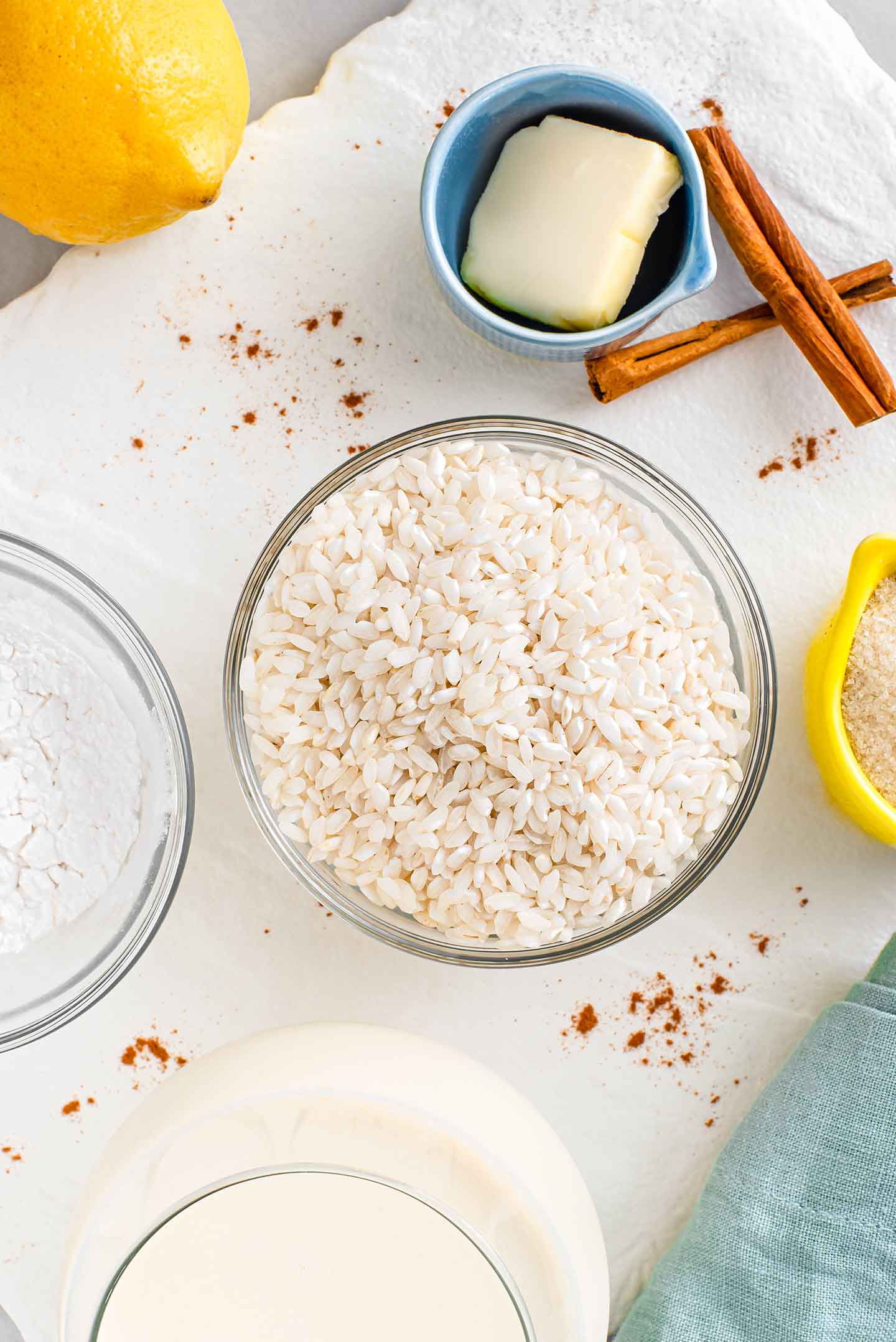
We use these wallet and pantry friendly ingredients for our sweet rice:
- 1 cup Arborio rice (short grain Italian rice)
- 1 tablespoon Vegan Butter
- 2 cups Soy Milk
- ½ teaspoon Lemon Zest (we always have some frozen for recipes like this!)
- ⅓ cup Cane Sugar
- ½ teaspoon Vanilla Extract
And we swap the egg yolk with a slurry made from:
- 2 tbsp Arrowroot Starch
- A pinch of Turmeric (for colour)
- And another 2 tablespoon Soy Milk
Decorate the top of the pudding with about:
- 1 tsp ground cinnamon
And your Portuguese sweet rice is ready to enjoy!
Cost Comparison
Our version of arroz doce makes 5 cups of sweet rice (at least 5 servings) and costs us CAD $3.47. We bring that cost down to $2.47 by using frozen lemon zest and not having to buy a fresh lemon specifically for this recipe!
Every time we have a lemon, lime, or even an orange that we don't need to zest, we zest it anyway and freeze the zest in a small container. That way, anytime we need a small amount (as is the case for this recipe) we have it!
If we were to make this Portuguese sweet rice with the traditional dairy and egg yolk it would cost us roughly: CAD $5.07.
Making the starch slurry in place of the eggs adds no time to the recipe, it thickens it beautifully, and it's thriftier!
How To Make Vegan Portuguese Sweet Rice
Start by combining 1 cup arborio rice with 2 cups water and a pinch of salt. Since we want the starch to thicken this pudding you don't need to rinse your rice. Bring the mixture to a boil, reduce the heat to a simmer, and simmer with the lid on for 10 minutes.
After 10 minutes, the rice will have absorbed most of the water and you can add in the next ingredients. Add the vegan butter (I find that this gives the pudding a richer taste in lieu of the fat from the eggs), the lemon zest, and 2 cups soy milk. Alternatively, add about 2 large pieces of lemon peel and you can fish them out at the end of the cooking time.
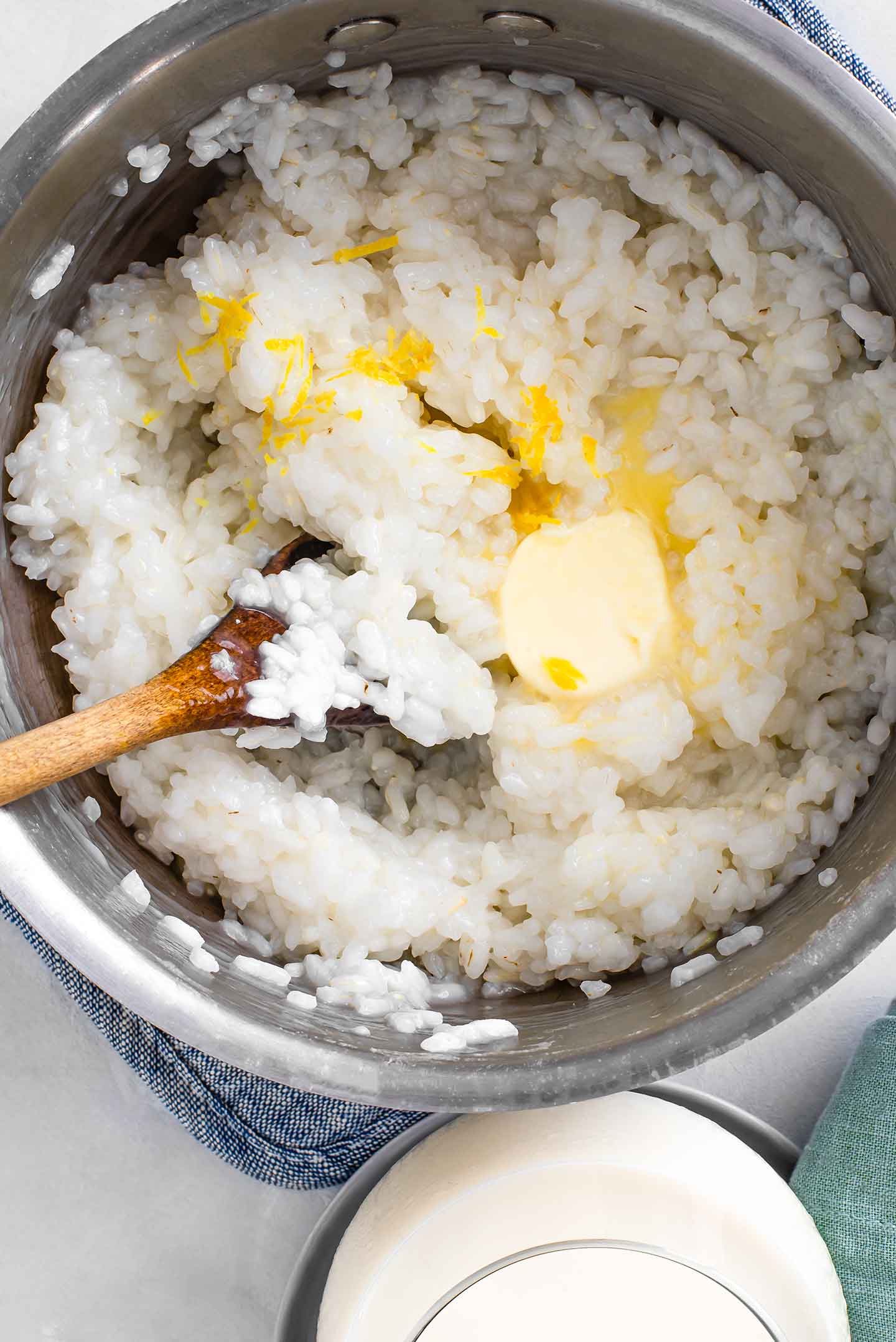
Bring the mixture back up to just before the milk boils, lower the heat again to a simmer, and allow the rice to cook for another 5 minutes with the lid on.
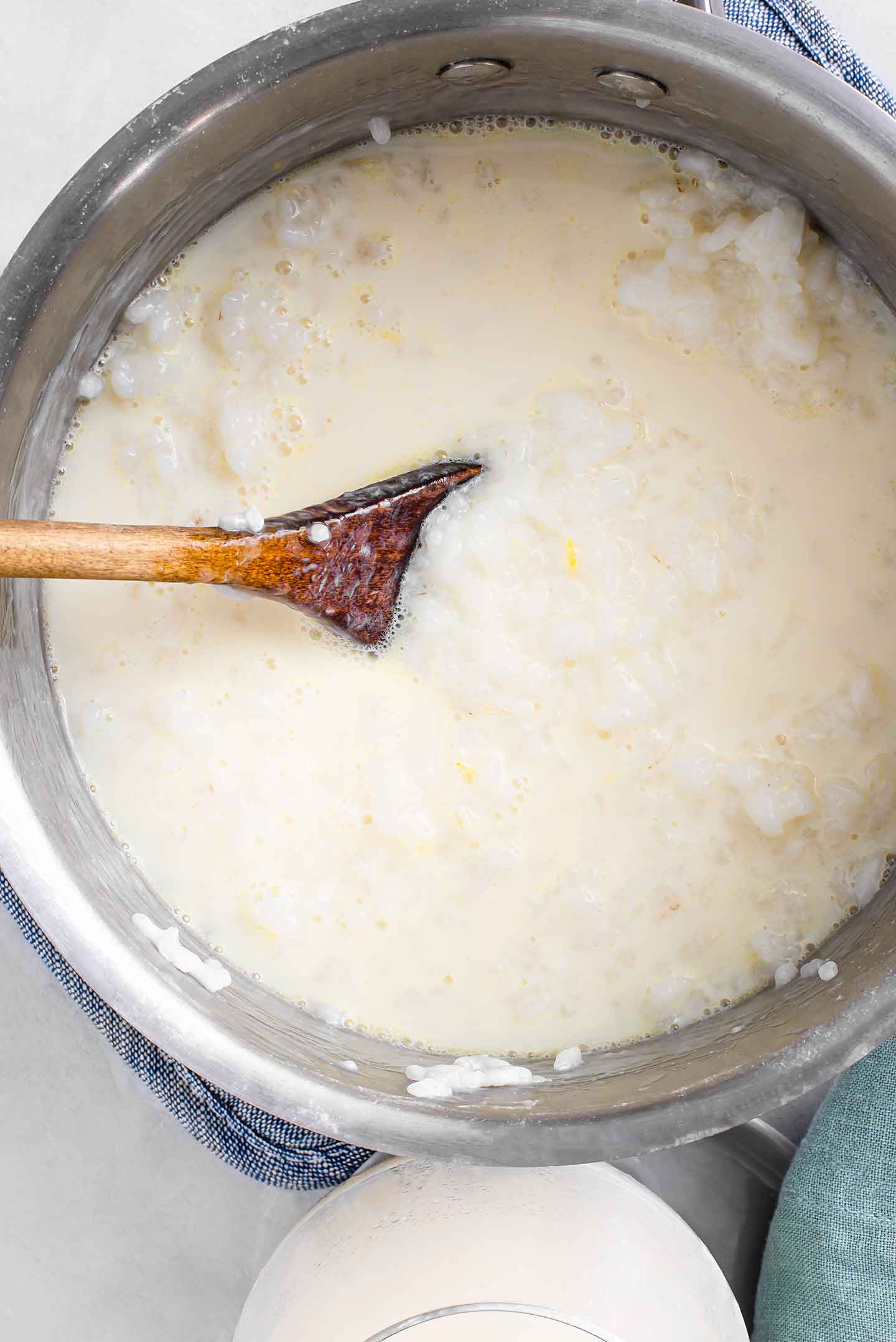
Then add the sugar and vanilla extract. The vanilla will help enhance all the other flavours! Cook the rice for another 2-5 minutes until it's tender. Give it a careful taste and allow it to cook for a few minutes more if needed.
When the rice is nice and soft, mix the slurry.
Making A Slurry
This is such a handy way to thicken sauces, gravy, or in this case... pudding!
Grab a small dish and whisk 2 tablespoon arrowroot starch (or cornstarch) with a pinch of turmeric (for some yellow colour in lieu of the eggs) and 2 tablespoon soy milk. Make sure the starch is fully combined in the milk. This is now a slurry! A slurry is a combination of starch or flour and a small amount of liquid that when added to something hot... will thicken it!
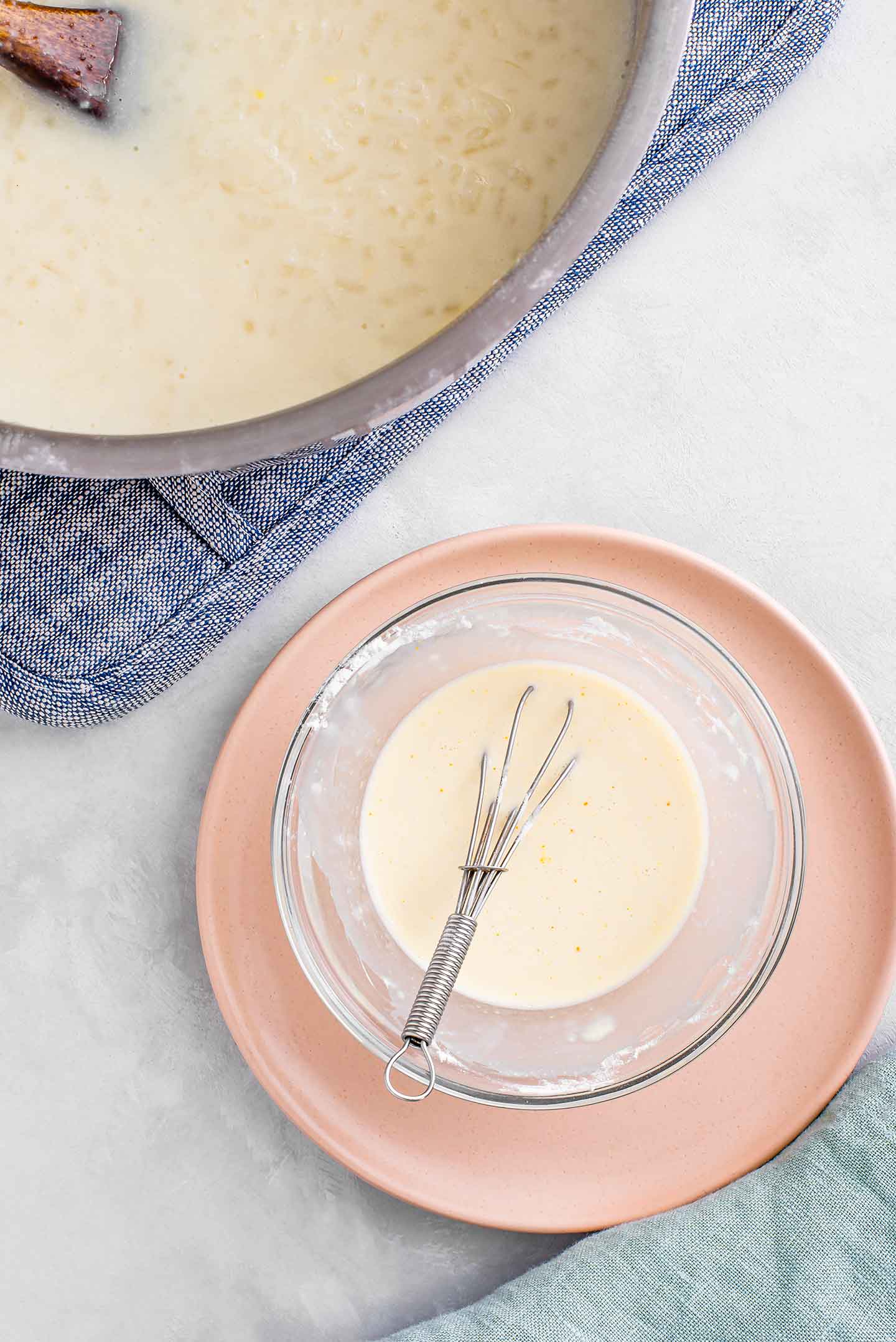
With the heat on low, slowly add in the slurry a little at a time. Stir vigorously with your other hand. You want to make sure the rice isn't too hot as you add the slurry because it may clump before you can get it smoothly incorporated.
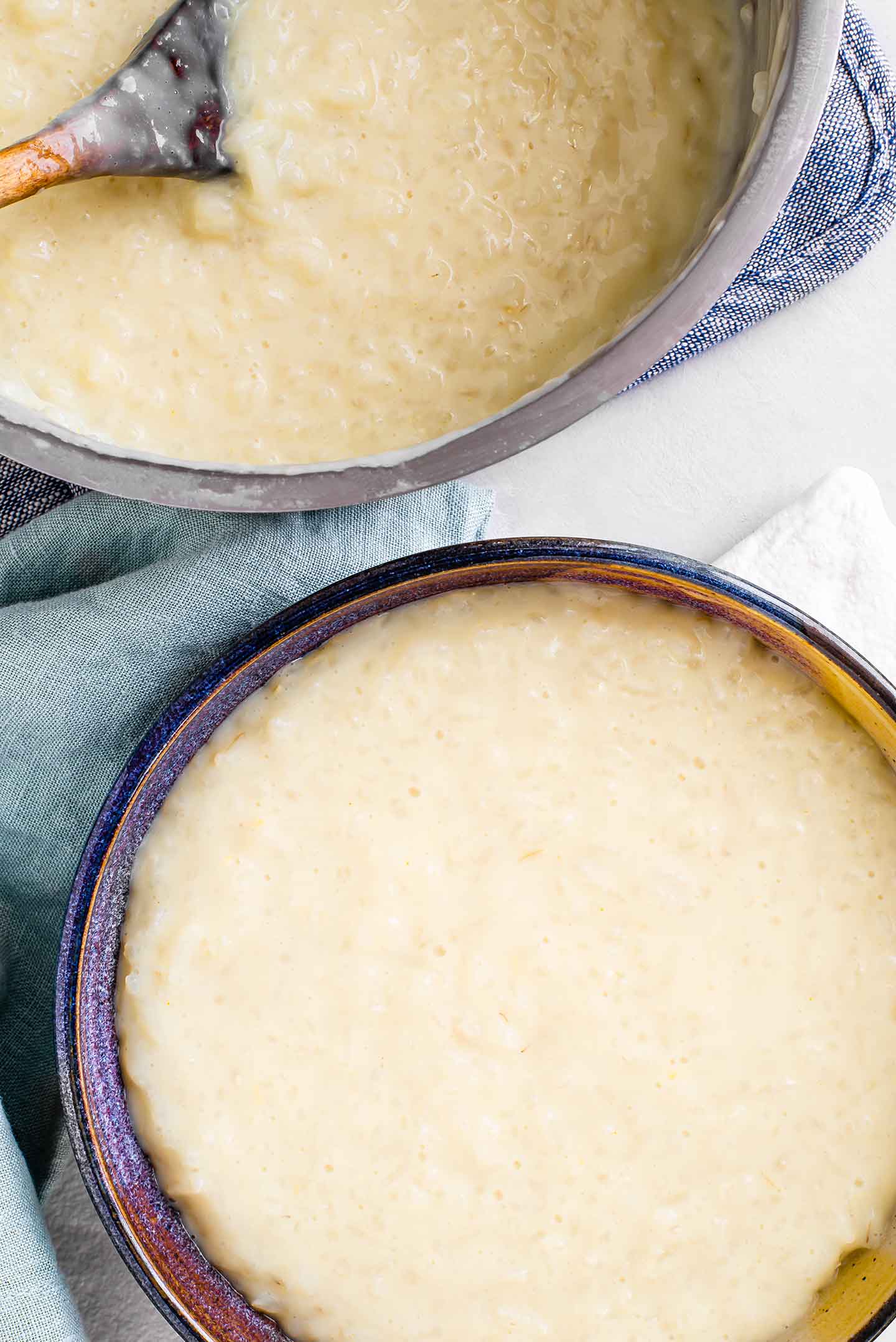
I find that arrowroot starch activates at a lower temperature but cornstarch needs to be brought up to a boil and then reduced to a simmer for a couple of minutes to activate. To make sure the starch activates:
Increase the heat and, stirring constantly, bring the pudding back up to a boil. Immediately reduce the heat to a simmer and cook, stirring, for an additional 2-3 minutes.
The slurry will thicken the rice and if you scoop some up it should stick to the spoon for a moment before dropping back down. Keep in mind the rice will continue to thicken a bit as it cools.
Immediately divide the rice between serving bowls (I use 2-3) and allow to cool down on the counter for about 1 hour.

Decorating Portuguese Sweet Rice
If you can't wait to dig in you can enjoy your sweet rice warm! But arroz doce is traditionally served cold and decorated once the rice has cooled. If you add the cinnamon topping while the rice is warm it may melt a bit into the rice.
To decorate the top, pinch the cinnamon between two fingers and sprinkle it over the sweet rice in a criss cross pattern. Alternatively, simply sprinkle cinnamon on top or use a dampened shot glass to create overlapping circles. Even use a stencil. Get creative!
And now you're ready to serve! Your sweet rice will keep well in the fridge for 2-3 days and it is perfect for gifting to family and friends!
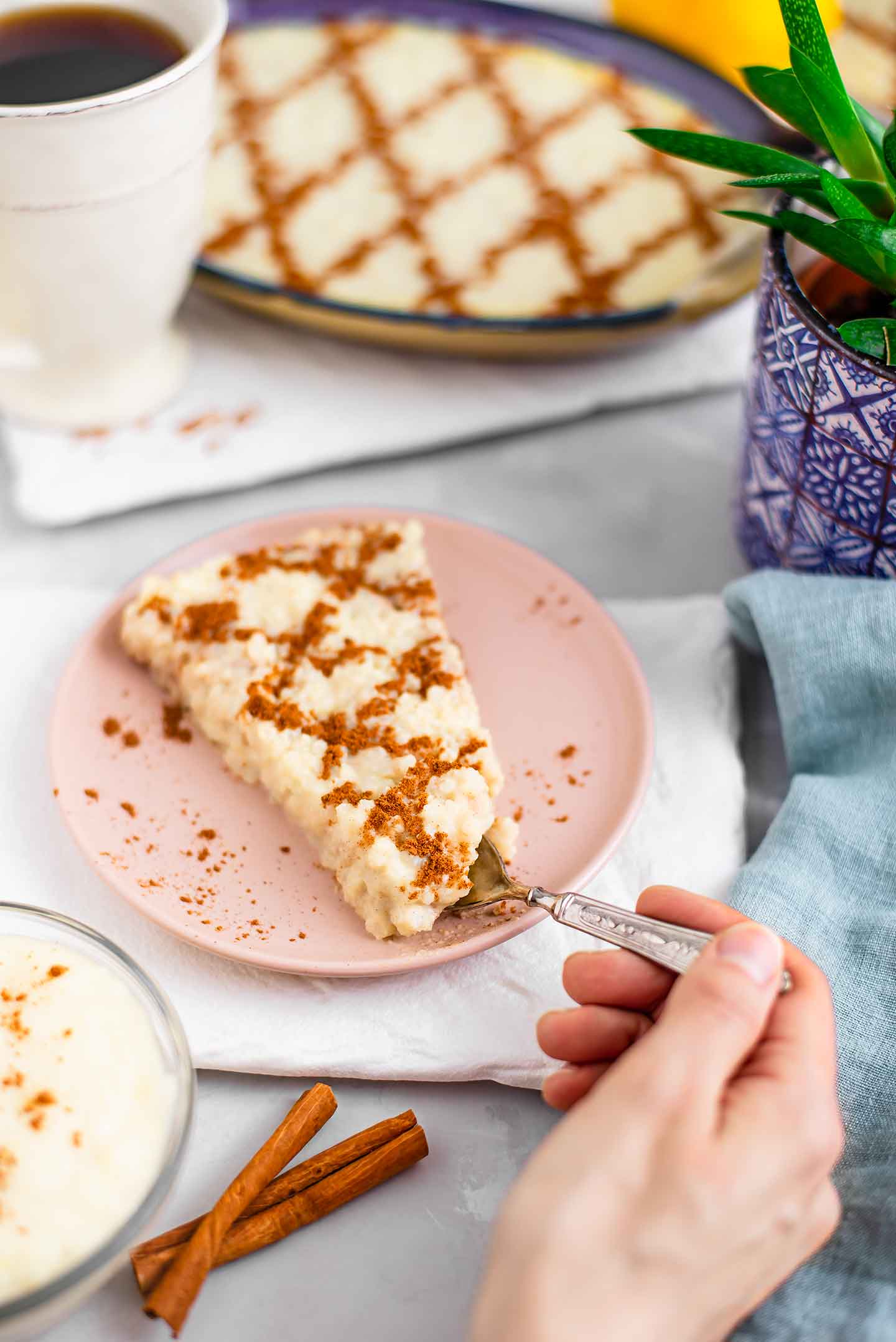
Let me know how you flavour your sweet rice in the comments below. Feel free to use more lemon, orange zest, or just vanilla!
Make sure to get a copy of my ebook "Da Terra" with 25 Vegan Portuguese Recipes including the famous Portuguese custard tart - pastel de nata!
Print
Vegan Portuguese Sweet Rice - Easy Arroz Doce
- Total Time: 40 minutes (plus 1 hr to chill if desired)
- Yield: 5 cups 1x
- Diet: Vegan
Description
Vegan Portuguese sweet rice is an easy sweet pudding! Made even thriftier than the traditional with no extra time & all the tasty comfort!
Ingredients
- 1 cup arborio or short grain Italian style rice
- 2 cups water
- Pinch of salt
- 1 tbsp vegan butter
- 2 cup soy milk + 2 tablespoon (for the starch slurry)
- ½ tsp lemon zest (can use frozen)
- ⅓ cup cane sugar (or more to taste)
- ½ tsp vanilla extract
- 2 tbsp arrowroot starch (or cornstarch)
- Pinch of turmeric (for a bit of yellow colour)
- 1 tsp cinnamon (for the topping)
*All the ingredients for this recipe are from our pantry and freezer tips!
Instructions
- Add the rice, water and salt to a medium saucepan. Bring to a boil then turn the heat down to low and simmer with the lid on for 10 minutes.
- Remove the lid and stir in vegan butter (I find this helps give a richer taste to the rice in lieu of the traditional egg yolks). Then, slowly add the milk ½ cup at a time and stir until evenly combined. Stir in the lemon zest (alternatively, use long strips of lemon peel and remove them at the end of the cooking time).
- Increase the heat to medium and bring the mixture back up to just before it boils. Then lower the heat again and simmer with the lid on for another 5 minutes.
- After 5 minutes, stir in the sugar and vanilla extract. Put the lid back on and simmer for another 2-5 minutes to get the rice really tender. Carefully taste the rice and double check that it is soft.
- Keep the rice over low heat and prepare the slurry. Whisk the starch and a pinch of turmeric in a small dish. Then add 2 tablespoon soy milk and whisk until it makes a smooth slurry with no starch visible and no clumps.
- Slowly add the slurry to the rice, a little at a time, while you quickly stir with your other hand. This will ensure that it’s evenly incorporated and won’t clump. *I find that arrowroot starch can activate at a lower temperature but cornstarch needs to be brought up to a boil and then reduced to a simmer in order to activate.
- Stirring constantly, bring the rice back up to a boil then reduce to a simmer and allow to thicken for 2-3 minutes. The rice is thick enough when it doesn't immediately slide off the spoon. Instead, it should stick to the spoon for a moment before dropping off. *If you can still taste the starch, cook for another minute or so to reduce that starch flavour.
- Immediately spread the rice about 1 ½ inch thick on serving plates or in shallow bowls (you can serve it in individual pudding cups if preferred). You can enjoy it right away but it is traditionally served chilled. Set it to fully cool on the counter for about 1 hour.
- Once cool, decorate your rice by making a criss cross pattern with the cinnamon. Pinch the cinnamon between two fingers and sprinkle it on the rice. (The cinnamon may melt into the rice if added when the rice is warm). Slice or scoop portions from the serving plate to serve!
- Store in the fridge and serve cold or reheat if desired. Lasts 3-4 days in the fridge.
Notes
Approximate Cost: CAD $3.47 ($2.47 without purchasing a fresh lemon, we love to use frozen citrus zest! Anytime you’re not using the zest of a lemon, lime, or orange - zest it anyway and freeze it in a little container for recipes like this one!)
Cost Comparison: CAD $3.47 vs. $5.07 if we use dairy milk, dairy butter, white sugar, and 3 egg yolks.
For a soy free version you could substitute with another plant milk. Alternatively, I tried a version substituting the soy milk and the starch slurry with 1 ¾ cup cashew cream (¾ cup soaked cashews blended with 1 cup cashew milk). The cashew cream added in place of the milk was enough to thicken the rice right away. The taste was very similar to the traditional but the texture was much more grainy. If you don’t mind a grainier texture you can give that a try. Full fat coconut milk could be another nut and soy free option.
- Prep Time: 10 minutes
- Cook Time: 30 minutes
- Category: Dessert
- Method: Stovetop
- Cuisine: Portuguese





Sheelagh
Easy and delicious recipe! Great for dessert or even breakfast!
Kathryn Alexandre
Ooo I like the breakfast idea! I'll have to try that next time I make it! I'm so glad you enjoy it at any time of the day!
Steve Johnson
Hi, Kathryn. Lovely recipe. I made it this morning, tweaking to taste as I went along. I ate this pudding about 4 days a week in the 1950's from age 4-13 as it was the only way my mother could get milk and eggs into me (hated both from infancy).
I've also been a dietary vegan for 25 years, developing recipes all that time. One essential modification I'd like to suggest, whenever you are making vegan pudding, pie fillings, flans, etc. that normally would have had egg in them: use about 1/8 tsp of Kala Namak (Black Salt) in the recipe to get the vague Sulphur overtones that eggs impart to any dish. It'll smell too strong as it goes in, but after cooking it's just right. One 1/2 cup jar of Kala Namak will last you several years.
Your recipe, to my taste buds, also needs a little more salt to balance the sugar (which I increased to 110 g), and wake up the tongue. Kala Namak is salty, so the trick is to add the 1/8 tsp late in the recipe, and then switch to plain salt, continuing to add carefully until the flavors "pop". I used 1/8 tsp of each this morning.
Finally, I've tried a LOT of vegan butters, and to my taste, nothing touches Miyoko, which I recommend.
PM me and I'll send you a recipe for a 100% vegan Butterscotch Meringue Pie to try.
Susie
Love this as it reminds me of my childhood
Kathryn Alexandre
This is so great to hear! Thank you for trying it and letting me know!